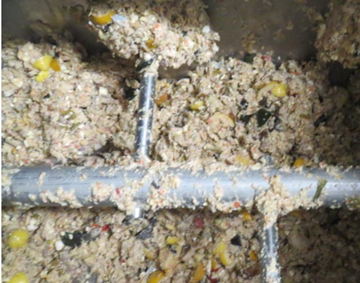Compliance and the Use of Food Waste Digesters on Ships

[By Wei Chen, Gerhard Schories, Oliver Jost, Niclas Karlsson and Markus Joswig]
A food waste digester, or biodigester as they are sometimes referred to, is a refrigerator-sized machine that handles food waste. The waste is fed into it via a lid on its top, water and sometimes enzyme is introduced, and the mixture is agitated, together with plastic media as used in some machines, for a period of some hours. The liquid is then passed through a screen to the drain. The system should not be confused with an anaerobic digester for biogas production.
On land, the food waste digesters are popular with hotels, schools, restaurants and canteens. They avoid costly collection fees, they remove the hygiene and smell issues of storing waste on site, and they pose less risk of blocking sewers than food waste disposers (grinders). Over the last decade, food waste digesters have also found their way onto passenger ships, large and small.
A ship’s food waste is regulated by the MARPOL Annex V convention. Because foreign food waste may carry pests and diseases, many countries have their own national biosecurity laws [1-5] prohibiting release into the local environment including the territorial waters and local sewer systems, and demanding that food waste is stored separately onboard and transported in sealed containers to the authorised facilities for disposal. These national laws are well recognized and respected by the IMO (MEPC.259(71)). However, when food waste and its derivatives are designated and managed as unregulated waste, e.g. grey water, both the international marine rules and national biosecurity rules become violated. The diagram below illustrates the extent of non-compliances as a result of such incorrect designation and handling procedures.

Unfortunately, such non-compliant designs have been endorsed by some Flag States, at the expense of the agricultural interests of many Port States and the integrity of their national biosecurity regulations. Once approved, little can be done by ship operators and masters. Even marine and biosecurity inspectors may have to simply ignore it. These non-compliances, therefore, continue to spread unchallenged. It is unimaginable that food waste digesters would be used by the aviation industry which is subject to the same biosecurity rules [6,7].
Compliant use of food waste digesters on board ships can be easy: simply label and manage the liquid discharge as food waste and keep it separate from the ship’s black and grey water systems. Correct design and appropriate approvals are essential.
What does a food waste digester really do?
Food waste is a challenge faced by modern society. Many competing solutions with unique features co-exist. Some food waste digesters have been marketed as being beyond a simple hygiene-friendly fee-saving machine, and promoted as an eco-warrior.
A food waste digester is claimed to turn over 90% of the organic carbon into carbon dioxide and has lower impact on climate change than windrow composting and anaerobic digestion [8, 9]. But a food waste digester is not designed to let oxygen in or to let carbon dioxide out. It may have a ‘steel stomach’, but it has no lung.
Not everyone takes such claims for granted. After some controlled tests, a research institute revealed the two main processes taking place in the digester are a mechanical stress on the food waste by agitation which leads to smaller particle sizes and a biochemical hydrolysis process aided by the additives which turns long-chain organic compounds to short-chain organic acids [10]. Also, not all food waste is hydrolysed.
 [Left: residual food waste left in a media-free biodigester over a test period of 30 hours that required manual removal]
[Left: residual food waste left in a media-free biodigester over a test period of 30 hours that required manual removal]
Under the IMO’s regulatory framework, a ship’s food waste can be discharged into the sea in accordance with MARPOL Annex V. As such, food waste is reused as a natural resource whilst a band of sea water can serve as a safety barrier to biosecurity risks. The jury is still out on what could be the most environmentally friendly and sustainable disposal route for ship’s international food waste, that is also compliant.
Green technologies should certainly be exploited to their full potential. But the investments should serve the purpose of environmental compliance. A food waste digester is no exception.
Co-authors
Dr Wei Chen, Future Program Development Manager, Wartsila Water Systems, UK
Dr Gerhard Schories, Head of Institute, ttz Bremerhaven, Germany
Oliver Jost, Maritime Environmental Affairs, Wasserschutzpolizei (Water Police) Hamburg, Germany
Niclas Karlsson, Managing Director, Clean Ship Scandinavia AB, Sweden
Markus Joswig, Head of Marine Department, Testing Institute for Wastewater Technology GmbH (PIA GmbH), Germany
Endorsed by
Alexandra Myers, Chief Engineer, Sea Education Association, USA
Dr Daniel Todt, Project Manager R&D, Ecomotive AS, Norway
Antony Chan, Engineering Manager, Victor Marine Ltd., UK
Dr Ramona Pristavita, Director, Product Development, Health & Safety, Terragon Environmental Technologies, Canada
Benny Carlson, Chairman and owner, Marinfloc, Sweden
Ed White, Environmental Consultant, former Alaska DEC cruise ship compliance manager, USA
Felix von Bredow, CEO, Hamman AG, Germany
Lisa Hammock, Senior Consultant, Defence & Security, BMT, UK
Mats Riska, Head of Concept & Process Development, Evac Oy, Finland
Kevin Bendel, Technical Sales, Martin Systems GmbH, Germany
References
[1] Animal by-products regulation (EC) No 1069/2009, EU
[2] Title 7 CFR 330.400 -330.403 and Title 9 CFR 94.5, USA
[3] Health of Animals Regulations (C.R.C., c. 296), Canada
[4] https://www.agriculture.gov.au/biosecurity/avm/vessels, Australia
[5] Craft Risk Management Standards for Vessels, MPI, 2018, New Zealand
[6] https://www.iata.org/contentassets/821b593dd8cd4f4aa33b63ab9e35368b/summary-icw-case-for-smarter-regulation.pdf
[7] http://www.mediacentre.gatwickairport.com/press-releases/2017/17_03_24_waste_plant.aspx
[8] https://wpmgreenenergy.com/wp-content/uploads/2019/08/2018_09_21-LCA-Summary.pdf
[9] Life cycle assessment for the ORCA technology, Golder Associates, 2015
[10] Test trials with a bio-digester/converter for food waste and additional analytics, Prof. Dr.-Ing. Gerhard Schories, ttz Bremerhaven, 2017.
The opinions expressed herein are the author's and not necessarily those of The Maritime Executive.

